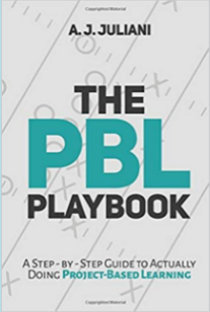A Guide to Actually Doing Project Based Learning
The PBL Playbook: A Step-By-Step Guide to Actually Doing Project-Based Learning
By A.J. Juliani
(Write Nerdy Publishing, 2018 – Learn more)

At the request of our school district’s Curriculum Director, I was asked to facilitate a Professional Learning Community on the topic of Project-Based Learning this school year into next.
PLC on PBL. I even thought about bringing peanut butter and jelly sandwiches to our first gathering early in the school year, just to keep the letter flow going: PLC on PBL with PBJ.

A quick aside: Project-Based Learning is different from curriculum units with a project at the end. In PBL, student choice of topics, based on interest, is a key component, as is individualized research, progress monitoring over time, and some sort of public sharing or public service project that informs the larger community at the end of a PBL venture.
Every student’s move into inquiry will be different from every other, and every end project will have its own individual flavor. Some students may do TED-style talks to a public audience. Others might build some invention or prototype. Others still may launch a public service campaign on a specific issue. And on and on.
The PBL Playbook
I stumbled upon A.J. Juliani’s appropriately named The PBL Playbook in the summer and quickly realized that this resource would be the perfect book talk text for my small group of colleagues across the elementary schools in our district. We all have copies of it now as a common resource, thanks to our Curriculum Director.
If you don’t know much about Juliani – and his work with his friend and collaborator Jon Spencer – it is a pleasant discovery, as Juliani often shares freely about his work with students, and now with teachers in his administrative role, along the lines of design process, inquiry models, personalized learning, and student-centered curiosity.
As noted, PBL is centered on the concept of students making choices, with teachers acting as sounding boards and guides. Within that freedom of choice comes responsibility for learning, to twist the words of Spiderman. It is likely this sense of “unfettered freedom to explore” that causes many teachers to pause at the door of PBL. We have curriculum to follow. We have students who need structure. We have limited resources.
Luckily, Juliani put my mind at ease, showing me how this freedom of choice often leads to important learning discoveries for students and teachers alike, and how a teacher can adapt the process to harness PBL freedom and still meet curriculum and learning goals. And in the end, if our goal is to help our students become creative and flexible thinkers, then PBL offers a path forward.
So, there’s much to like in The PBL Playbook. The text is built around practical advice for implementation, and teacher and student experiences. Juliani himself tells his own classroom stories of success and failures along the way, and lessons he has learned and adjustments made.
The book is also packed with many stories of teachers and classrooms across the spectrum, where PBL – also known as Genius Hour, 20 Percent Time, Passion Projects, or many other names – is shown unfolding in a variety of curriculum areas. For newcomers, these stories are a lifeline, a series of mentor examples to consider before starting PBL.
Juliani is also generous with examining many lesson plans to help teachers get started as well as sharing a myriad of administrative documents – like how to help students discover an inquiry topic, or how to keep track of conferencing with students over extended periods of time, or how to assess the work that goes into an inquiry project.
If you are considering PBL, consider The PBL Playbook as a practical guide to get you started and moving forward.
AJ Juliani shares much thinking at his blog: http://ajjuliani.com/blog-2/ and he often has offers for free books, such as this one for a free copy of The PBL Playbook, if it is still active.
__________________________________________
Kevin Hodgson is a sixth grade teacher in Southampton, Massachusetts, and is Co-Director for Outreach with the Western Massachusetts Writing Project. Kevin blogs regularly at Kevin’s Meandering Mind and tweets more often than is healthy under his @dogtrax handle. He blogged regularly for MiddleWeb at Working Draft from 2013-2018.

































